
김정희 (1786-1856)
김정희는 조선후기 조선 금석학파를 성립하고, 추사체를 완성한 문신이다. 실학자이자 서화가이기도 하다. 1786년(정조 10)에 태어나 1856년(철종 7)에 사망했다. 24세 때 생부 김노경을 따라 연경에 가서 옹방강·완원 같은 청의 이름난 유학자들과 교유하며 진적을 함께 감상하고 경학 및 금석문과 서법에 대한 가르침을 받고 귀국했다. 이후 조선 금석학파를 성립시켰고 독특한 추사체를 완성시켰다. 문인화론을 바탕으로 뛰어난 시서화 작품을 다수 남겼고 불교에 대한 이해도 높았다. 11년 동안 제주도와 함경도 북청에서 유배생활을 했다.
[자세히보기]출처 : 한국민족문화대백과사전
Kim Jeonghui (1786-1856)
Kim Jeong-hui, was one of the most celebrated practitioners of calligraphy, epigraphists, and scholars of Korea’s later Joseon period. He is especially celebrated for having transformed Korean epigraphy and for having created the “Chusa-che” Chusa writing style) inspired by his study of ancient Korean and Chinese epitaphs. His ink paintings, especially of orchids, are equally admired.
[Learn more]Source : Wikipedia
□ Sehando /세한도 (국보 180호)

김정희필 세한도
조선 말기의 사대부 서화가 완당 김정희가 1844년 제주도 유배지에서 수묵으로만 간략하게 그린 사의체의 문인화이다. 1840년 윤상도사건에 연루되어 지위와 권력을 박탈당하고 제주도로 귀양 온 김정희에게 사제간의 의리를 지키기 위해 두 차례나 북경으로부터 귀한 책을 구해다 준 역관인 우선 이상적의 인품을 날씨가 추워진 뒤에 제일 늦게 낙엽지는 소나무와 잣나무의 지조에 비유하여 그려 준 것이다.
[자세히보기]출처 : Wikipedia
Sehando
In 1844, during his exile in Jeju Island, Kim Jeong-hui produced this, his most celebrated ink painting, usually known as “Sehando” or “Wandang Sehando”. ‘Wandang’ was one of Kim’s most frequently used ‘Ho’ names; ‘Sehan’ means ‘the bitter cold around the lunar new year,’ ‘do’ means ‘painting’). He gave to his disciple Yi Sang-jeok in gratitude for his friendship.
[Learn more]Source : Wikipedia










 HOME
HOME

 0
0




